Ursa Major constellation lies in the northern sky. Its name means “the great bear,” or “the larger bear,” in Latin. The smaller bear is represented by Ursa Minor.
Ursa Major is the largest northern constellation and third largest constellation in the sky. Its brightest stars form the Big Dipper asterism, one of the most recognizable shapes in the sky, also known as the Plough. Ursa Major is well-known in most world cultures and associated with a number of myths. It was one of the constellations catalogued by the Greek astronomer Ptolemy in the 2nd century. In Greek mythology, it is associated with Callisto, a nymph who was turned into a bear by Zeus’ jealous wife Hera.
Ursa Major contains a number of notable stars and famous deep sky objects. These include the Pinwheel Galaxy (M101), Bode’s Galaxy, the Cigar Galaxy, and the Owl Nebula.
Myth, location and map
Ursa Major is a well-known, significant constellation in many cultures. It is one of the oldest constellations in the sky, with a history dating back to ancient times. The constellation is referenced in Homer and the Bible. A great number of tales and legends across the globe associate Ursa Major with a bear.
Ancient Greeks associated the constellation with the myth of Callisto, the beautiful nymph who had sworn a vow of chastity to the goddess Artemis. Zeus saw the nymph one day and fell in love. The two had a son, and named him Arcas. Artemis had already banished Callisto when she had learned about the nymph’s pregnancy and broken vow.
However, it was Zeus’ jealous wife Hera, who was not amused by her husband’s philandering, who would do even more damage. Angered by Zeus’ betrayal, she turned Callisto into a bear.
Callisto lived as a bear for the next 15 years, roaming the forest and always running and hiding from hunters. One day, her son Arcas was walking in the forest and the two came face to face. At the sight of the bear, Arcas quickly drew his spear, scared.
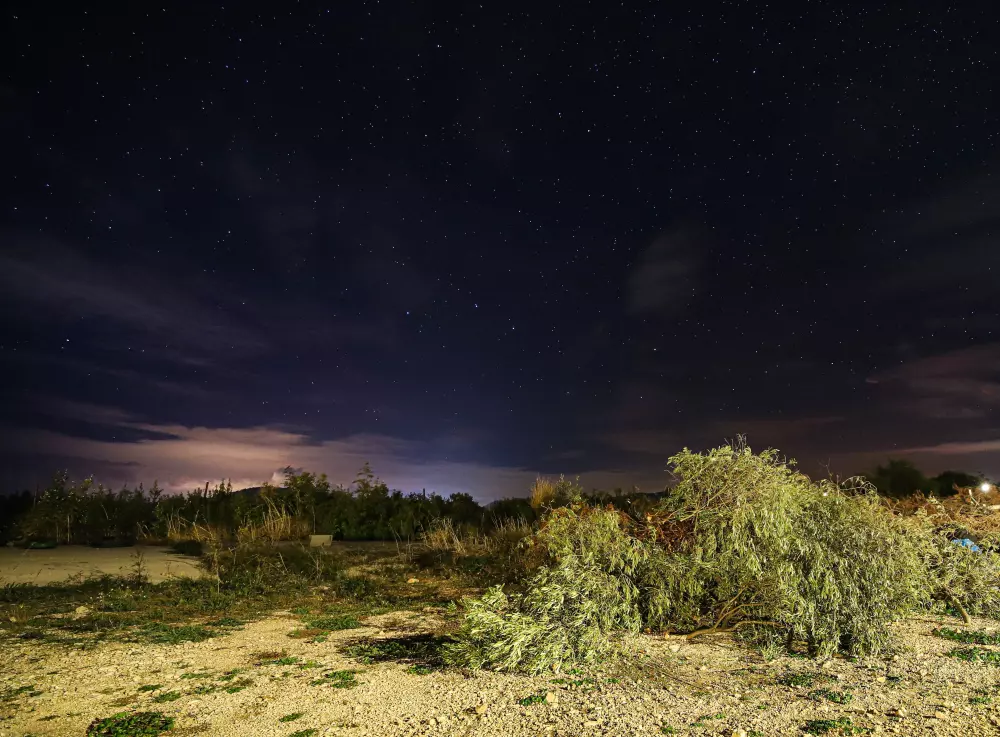
Ursa Major, image: Constellation Guide
Seeing the scene from Olympus, Zeus intervened to prevent a tragedy. He sent a whirlwind that carried both Callisto and Arcas into the heavens, where he turned Arcas into the constellation Boötes, the Herdsman, and Callisto into Ursa Major. (In another version, Arcas becomes the constellation Ursa Minor.) This only further infuriated Hera and she persuaded her foster parents Oceanus and Tethys never to let the bear bathe in the northern waters. This, according to the legend, is why Ursa Major never sets below the horizon in mid-northern latitudes.
In a different version of the tale, it is not Hera but Artemis who transforms Callisto into a bear. Artemis does this to punish the nymph for breaking her vow of chastity to the goddess. Many years later, both Callisto and Arcas are captured in the forest and taken to King Lycaon as a gift. The mother and son take refuge in the temple of Zeus, and the god intervenes and saves them, placing them both in the sky.
There is an entirely different Greek myth associated with Ursa Major, the one about Adrasteia. Adrasteia was one of the nymphs who took care of Zeus when he was very young. Zeus’ father Cronus was told by an oracle that one of his children would eventually overthrow him and, fearful of the prophecy, Cronus swallowed all his children until Zeus was born. Rhea, Zeus’ mother, smuggled their youngest child to the island of Crete, where the nymphs Adrasteia and Ida nursed young Zeus for a year. In this version of the myth, Ida is associated with the constellation Ursa Minor. Amaltheia, the goat that nursed Zeus, was placed in the sky as the bright star Capella in the constellation Auriga. The prophecy eventually came true; Zeus overthrew Cronus and freed his brothers Hades and Poseidon and sisters Demeter, Hera and Hestia.
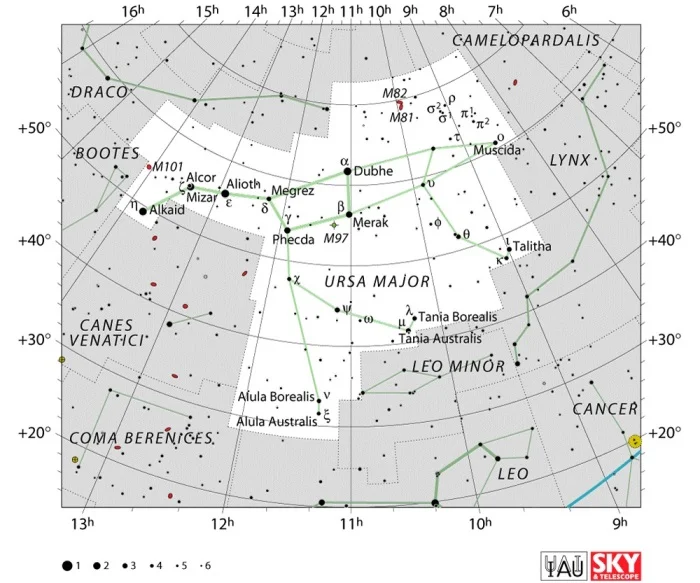
Ursa Major constellation map by IAU and Sky&Telescope magazine
The Romans called the constellation Septentrio, or “seven plough oxen,” even though only two of the seven stars represented oxen, while the others formed a wagon.
Ursa Major is associated with many different forms in the sky in different cultures, from the camel, shark and skunk to the sickle, bushel and canoe. The Chinese know the seven brightest stars, or Tseih Sing, as the Government, or Pih Tow, the Northern Measure.
In Hindu legend, the brightest stars of Ursa Major represent the Seven Sages and the constellation is known as Saptarshi. The sages in question are Bhrigu, Atri, Angirasa, Vasishta, Pulastya, Pulalaha and Kratu.
In some Native American tales, the bowl of the Big Dipper represents a large bear and the stars that mark the handle are the warriors chasing it. Since the constellation is pretty low in the sky in autumn, the legend says that it is the blood of the wounded bear that causes the leaves to turn red.
In more recent American history, the Big Dipper played a role in the Underground Railroad, as its position in the sky helped black people find their way north. There were numerous songs that spread in the south that said to follow the ‘Drinking Gourd’ to get to a better life.
Facts
Ursa Major is the third largest constellation in the sky, occupying an area of 1280 square degrees. It is located in the second quadrant of the northern hemisphere (NQ2) and can be seen at latitudes between +90° and -30°. The neighboring constellations are Boötes, Camelopardalis, Canes Venatici, Coma Berenices, Draco, Leo, Leo Minor and Lynx.
The constellation name Ursa Major is pronounced /ˌɜːrsə ˈmeɪdʒər/. In English, the constellation is known as the Great Bear. The genitive form of Ursa Major, used in star names, is Ursae Majoris (pronunciation: /ˌɜːrsiː məˈdʒɒrɪs/). The three-letter abbreviation, adopted by the International Astronomical Union (IAU) in 1922, is UMa.
Ursa Major contains seven Messier objects: Messier 40 (M40, Winnecke 4), Messier 81 (M81, NGC 3031, Bode’s Galaxy), Messier 82 (M82, NGC 3034, Cigar Galaxy), Messier 97 (M97, NGC 3587, Owl Nebula), Messier 101 (M101, NGC 5457, Pinwheel Galaxy), Messier 108 (M108, NGC 3556), and Messier 109 (M109, NGC 3992). It also contains 13 stars with confirmed planets.
The brightest star in the constellation is Alioth, Epsilon Ursae Majoris, with an apparent magnitude of 1.76.
The constellation Ursa Major contains 22 formally named stars. The star names approved by the International Astronomical Union (IAU) are Alcor, Alioth, Alkaid, Alkaphrah, Alula Australis, Alula Borealis, Aniara, Chalawan, Dombay, Dubhe, Intercrus, Liesma, Mazaalai, Megrez, Merak, Mizar, Muscida, Násti, Phecda, Taiyangshou, Talitha, Tania Australis, and Tania Borealis.
There are two meteor showers associated with the constellation; the Alpha Ursa Majorids and the Leonids-Ursids.
Ursa Major belongs to the Ursa Major family of constellations, along with Boötes, Camelopardalis, Canes Venatici, Coma Berenices, Corona Borealis, Draco, Leo Minor, Lynx, and Ursa Minor.
Major stars in Ursa Major
ASTERISM – THE BIG DIPPER (THE PLOUGH)
The Big Dipper is one of the most recognizable asterisms in the sky. It has significance in many different cultures.
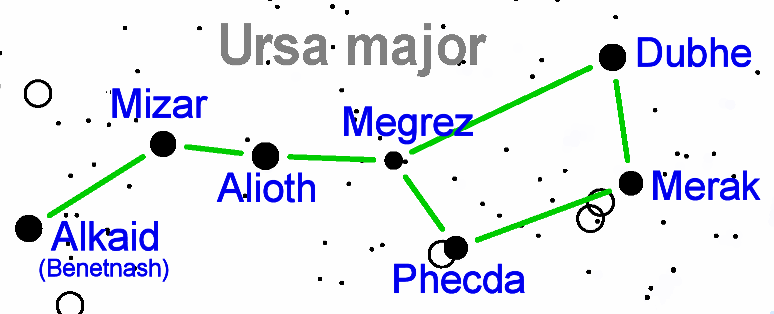
Big Dipper stars, image: Luigi Chiesa
The Big Dipper is also very useful in navigation as it points the way to Polaris, the North Star (Alpha Ursae Minoris), which is a part of another famous asterism, the Little Dipper in Ursa Minor constellation.
If you follow the imaginary line from Merak to Dubhe and continue the arc, you will eventually reach the Northern Star.
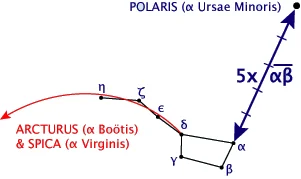
Similarly, the imaginary line that stretches along the handle of the Dipper leads to the bright star Arcturus, the bear keeper, located in the constellation Boötes, the Herdsman. If you follow the line further, you will find Spica, the brightest star in the constellation Virgo and also one of the brightest stars in the sky.
The seven stars that form the Big Dipper are Dubhe (Alpha Ursae Majoris), Merak (Beta UMa), Phecda (Gamma UMa), Megrez (Delta UMa), Alioth (Epsilon UMa), Mizar (Zeta UMa), and Alkaid (Eta UMa).
Alioth – ε Ursae Majoris (Epsilon Ursae Majoris)
Alioth is the brightest star in Ursa Major and the 31st brightest star in the night sky. It has an apparent magnitude of 1.76 and is approximately 81 light years distant. The star’s traditional name comes from the Arabic word alyat, which means “fat tail of a sheep.” Alioth is the star in the bear’s tail that is closest to the body of the bear.
Alioth belongs to the Ursa Major Moving Group (Collinder 285), a group of stars that includes most of the brightest stars in the constellation Ursa Major. The stars belonging to the group share common velocities in space and are believed to have a common origin.
The Ursa Major Moving Group was discovered in 1869 by the English astronomer Richard A. Proctor, who realized that all stars of the Big Dipper with the exception of Alkaid and Dubhe have proper motions heading toward a common point in the constellation Sagittarius. The stars Alpha Coronae Borealis, Beta Aurigae, Delta Aquarii, Gamma Leporis and Beta Serpentis are outlying members of the group.
Alioth belongs to the spectral class A0pCr. The p stands for peculiar because the star’s spectrum of light is similar to that of an Alpha-2 Canum Venaticorum variable. Alioth exhibits fluctuations in its spectral lines with a period of 5.1 days.
Dubhe – α Ursae Majoris (Alpha Ursae Majoris)
Dubhe has an apparent magnitude of 1.79 and is 123 light years distant from the solar system. It is the second brightest star in Ursa Major. The name Dubhe comes from the Arabic dubb, which means “bear,” from the phrase żahr ad-dubb al-akbar, or “the back of the Greater Bear.” Dubhe does not belong to the Ursa Major Moving Group.
Dubhe is a giant star belonging to the spectral class K1 II-III. It is a spectroscopic binary star. The companion is a main sequence star that belongs to the spectral type F0 V. It completes the orbit around the brighter star every 44.4 years from a distance of 23 astronomical units.
There is another binary system about 90,000 AU away from the main pair, which makes Alpha Ursae Majoris a four star system.
Merak – β Ursae Majoris (Beta Ursae Majoris)
The name Merak comes from the Arabic al-maraqq, which means “the loins.”
Beta Ursae Majoris is a main sequence star, approximately 79.7 light years distant, with a visual magnitude of 2.37. It belongs to the spectral class A1 V. The star has a debris disk of dust orbiting it, one with a mass 0.27 percent that of the Earth.
Beta Ursae Majoris is 2.7 times more massive than the Sun, has 2.84 times the radius, and is about 68 times more luminous. It belongs to the Ursa Major Moving Group and is a suspected variable star.
Alkaid – η Ursae Majoris (Eta Ursae Majoris)
Alkaid is the easternmost star in the Big Dipper asterism. It is also known as Elkeid and Benetnash. It is a young main sequence star belonging to the spectral class B3 V, approximately 101 light years distant. It has an apparent magnitude of 1.85 and is the third brightest star in the constellation and also the 35th brightest star in the night sky.
Alkaid is notable for being one of the hottest stars that can be seen without binoculars. It has a surface temperature of 20,000 kelvins. The star has six solar masses and is about 700 times more luminous than the Sun. Like Dubhe, Alkaid does not belong to the Ursa Major Moving Group.
The star’s traditional names, Alkaid and Benetnash (or Benetnasch), come from the Arabic phrase qā’id bināt na’sh, which means “the leader of the daughters of the bier.” The three stars marking the handle of the Big Dipper represent three mourning maidens, while the stars that form the body of the bowl represent the bier. The name Alkaid itself means leader.
In spite of being the third brightest star in Ursa Major, Alkaid was designated Eta Ursae Majoris because Johannes Bayer named the stars of the Big Dipper from west to east, designating the Pointer Stars Alpha and Beta.
Phecda – γ Ursae Majoris (Gamma Ursae Majoris)
Gamma Ursae Majoris is the lower left star in the bowl of the Big Dipper. It belongs to the Ursa Major Moving Group. The star’s traditional name, Phecda (or Phad), is derived from the Arabic phrase fakhð ad-dubb, which means “the thigh of the bear.”
Gamma UMa is a main sequence star of the spectral type A0 Ve. It has a visual magnitude of 2.438 and is approximately 83.2 light years distant. The –e in the star’s classification refers to it being an Ae star, one that has an envelope of gas surrounding it and adding emission lines to its spectrum.
Phecda’s estimated age is 300 million years. The star is located only 8.55 light years away from the Mizar-Alcor star system.
Megrez – δ Ursae Majoris (Delta Ursae Majoris)
Megrez, Delta Ursae Majoris, is the faintest of the seven bright stars that form the Big Dipper asterism. It is a main sequence star of the spectral type A3 V. It has a visual magnitude of 3.312 and is approximately 58.4 light years distant from the solar system. It is 14 times more luminous than the Sun and has 63% more mass. The star emits an excess of infrared radiation, which indicates a debris disk in its orbit.
The star’s name, Megrez, is derived from the Arabic word al-maghriz, which means “the base” (as in, the base of the bear’s tail).
Mizar – ζ Ursae Majoris (Zeta Ursae Majoris)
Zeta Ursae Majoris is a system composed of two binary stars. It can be found in the Big Dipper’s handle – it is the second star from the end.
The name Mizar is derived from the Arabic mīzar, which means “girdle” or “waistband.”
Mizar has an apparent magnitude of 2.23 and is approximately 82.8 light years distant. It was the first double star ever to be photographed. Early American photographer and inventor John A. Whipple and astronomer George P. Bond took the photo of the binary system in 1857 using a wet collodion plate and the 15-inch refractor telescope at Harvard College Observatory. Bond had previously also photographed the star Vega in Lyra constellation in 1850.
Alcor (80 Ursae Majoris)
Alcor is a visual companion to Mizar. It belongs to the spectral class A5V. The two stars are sometimes known as the “Horse and Rider.”
Alcor has a visual magnitude of 3.99 and is 81.7 light years distant from the solar system. It is also known as Saidak (“the test”), Suha (“neglected” or “forgotten”) and Arundhati in Indian cultures. Alcor was discovered to be a binary system in 2009.
Both Mizar and Alcor belong to the Ursa Major Moving Group. The estimated distance between the two stars is 1.1 light years.
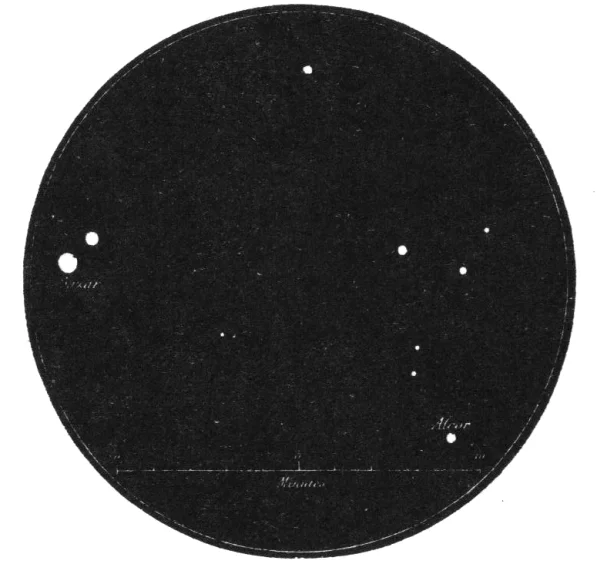
Mizar and Alcor, image: Camille Flammarion, Les étoiles et les curiosités du ciel, 1882
W Ursae Majoris
W Ursae Majoris is a prototype for a class of stars known as the W Ursae Majoris variables.
It is a binary system composed of two close stars in a circular orbit with a period of 0.3336 days. The stars are physically so close that their outer envelopes are in direct contact. Each star orbits the other during each orbital cycle, resulting in a decrease in brightness. The apparent magnitude of the system varies between 7.75 and 8.48. Both stars belong to the spectral class F8V.
Messier 40 (M40, Winnecke 4, WNC 4)
Winnecke 4 is another double star in Ursa Major. It was originally catalogued as a Messier object by Charles Messier in 1764, while he was looking for a nebula that Johann Hevelius reported seeing in the region. Not finding the nebula, Messier catalogued the binary star instead.
The German astronomer Friedrich August Theodor Winnecke rediscovered the star in 1863, and it was subsequently named after him.
Winnecke 4 has an apparent magnitude that varies between 9.65 and 10.10 and it is approximately 510 light years distant.
Chalawan – 47 Ursae Majoris
47 Ursae Majoris is a main sequence star belonging to the spectral class G1V. It is 45.9 light years distant from Earth. The star is a solar analog; it has a similar mass and is slightly hotter than the Sun, with about 110 percent of the Sun’s abundance of iron. It has an apparent magnitude of 5.03.
In 1996, a planet at least 2.53 times the size of Jupiter was discovered in the star’s orbit. Two more planets were discovered in the system in 2002 and 2010.
Alula Borealis and Alula Australis – ν (Nu) and ξ (Xi) Ursae Majoris – “the first leap”
Nu Ursae Majoris is another double star, one visible to the unaided eye. It has an apparent magnitude of 3.490 and is approximately 399 light years distant from the solar system. It is a giant star belonging to the spectral type K3 III with a radius 57 times that of the Sun, and about 775 times the Sun’s luminosity.
The star’s traditional name, Alula Borealis, is derived from the Arabic word al-Ūlā, which means “the first (leap),” and the Latin word for “northern,” borealis.
Xi Ursae Majoris, or Alula Australis, is the southern star of “the first leap.” It is in fact a star system first discovered by Sir William Herschel in 1780. Xi Ursae Majoris is composed of two main sequence dwarfs belonging to the spectral class G0 Ve. The system is only 29 light years distant. The brighter component has an apparent magnitude of 4.32, and the dimmer one, 4.84. The combined visual magnitude of the system is 3.79.
Xi Ursae Majoris is classified as an RS Canum Venaticorum type variable star. The RS Canum Venaticorum variables are close binary stars with large stellar spots caused by the stars’ active chromospheres. The spots in turn cause variations in luminosity around 0.2 magnitudes. In some cases, the fluctuations in brightness are caused by the stars being eclipsing binaries.
Each of the two main components in the Xi Ursae Majoris system is itself a spectroscopic double, and has a low mass companion. Xi Ursae Majoris is also notable for being the first binary star to have its orbit calculated, in 1828.
Nu and Xi Ursae Majoris are the first of three pairs of stars known to the ancient Arabs as the “leaps of the gazelle.”
Tania Borealis and Tania Australis – λ (Lambda) and μ (Mu) Ursae Majoris – “the second leap”
Lambda Ursae Majoris is a star belonging to the spectral class A2 IV, which means that it is evolving into a giant as its hydrogen supply becomes exhausted. The star has an apparent magnitude of 3.45 and is approximately 138 light years distant.
The star’s traditional name, Tania Borealis, means “the Northern (star) of the Second (leap).”
Mu Ursae Majoris, or Tania Australis, is the southern star of the pair. It is a red giant, belonging to the spectral type M0 lab, approximately 230 light years away. It has a visual magnitude of 3.06 and is classified as a semiregular variable star, with variations in brightness fluctuating between 2.99 and 3.33. Mu Ursae Majoris has a visual companion about 1.5 AU away.
Talitha and Alkaphrah – ι (Iota) and κ (Kappa) Ursae Majoris – “the third leap”
Iota Ursae Majoris is a star system composed of two double stars, a white subgiant of the spectral type A7 IV that is in fact a spectroscopic binary, and another pair of 9th and 10th magnitude stars. When the B component was first discovered in 1841, the two binary stars were separated by 10.7 arc seconds. The distance between the two has decreased dramatically since, and is now only 4.5 arc seconds. The two components orbit each other with a period of 818 years. Iota Ursae Majoris is approximately 47.3 light years distant from the solar system.
Kappa Ursae Majoris is another binary star in Ursa Major, composed of two A-type main sequence dwarfs with visual magnitudes of 4.2 and 4.4. The system has an apparent magnitude of 3.60 and is about 358 light years distant.
Muscida – ο Ursae Majoris (Omicron Ursae Majoris)
Omicron Ursae Majoris is a multiple star system about 179 light years distant. It belongs to the spectral class G4 II-III, which means that it is somewhere between a giant and bright giant on the evolutionary scale. It has an apparent magnitude of 3.35. The star’s traditional name, Muscida, means “the muzzle.”
Groombridge 1830
Groombridge 1830 is a subdwarf belonging to the spectral class G8V, only 29.7 light years from the Sun. It was catalogued by the British astronomer Stephen Groombridge in the early 19th century in his Catalogue of Circumpolar Stars, published posthumously in 1838.
When it was discovered, Groombridge 1830 was the star with the highest proper motion of any star known. It dropped to third place with the discovery of Kapteyn’s Star in the constellation Pictor and Barnard’s Star in Ophiuchus.
Like Kapteyn’s Star, Groombridge 1830 is a halo star, one that appears to be moving in the direction opposite to the galaxy’s rotation because it does not follow the rotation of the Milky Way. Halo stars are typically metal-poor, because they were created in an earlier age of the galaxy. Most halo stars are located either far above or below the galactic plane and are believed to be at least 10 billion years old. They have highly eccentric orbits and a high space velocity.
Lalande 21185
Lalande 21185 is a red dwarf (spectral type: M2V) only 8.31 light years distant from the Sun. It has an apparent magnitude of 7.520 and cannot be seen by the unaided eye. It is the fourth closest star system to our solar system, after Alpha Centauri, Barnard’s Star and Wolf 359. In about 19,900 years, it will come within 4.65 light years from the Sun.
Lalande 21185 is classified as a BY Draconis type variable and is a known X-ray source.
ψ Ursae Majoris (Psi Ursae Majoris)
Psi Ursae Majoris is an orange giant, belonging to the spectral type K1 III. It has a visual magnitude of 3.01 and is about 144.5 light years distant. The Chinese know it as Tien Tsan or Ta Tsun, which means “exceptionally honourable.”
Deep sky objects in Ursa Major
Bode’s Galaxy – Messier 81 (M81, NGC 3031)
Messier 81 is a bright, large spiral galaxy about 11.8 million light years distant from Earth. Because of its relative proximity and brightness – it has an apparent magnitude of 6.94 – M81 is a popular target both for beginners and professional astronomers. The galaxy’s apparent size is 26.9 x 14.1 arc minutes. Only one supernova has been discovered in it: SN 1993J, in March 1993.
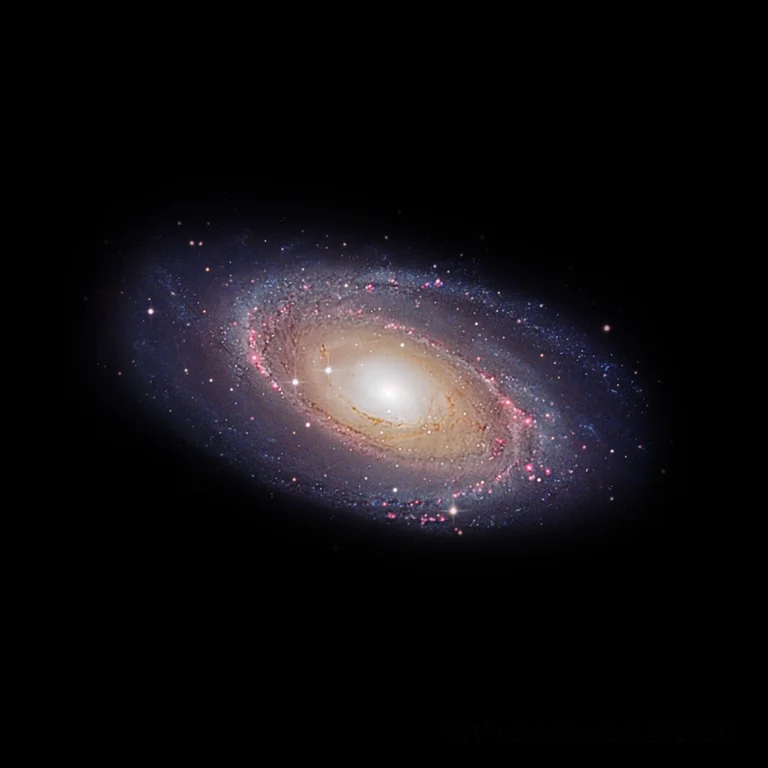
Bode’s Galaxy (Messier 81), image: Pablo Carlos Budassi (CC BY-SA 4.0)
Bode’s Galaxy was discovered by the German astronomer Johann Elert Bode in 1774. In 1779, Charles Messier identified the galaxy independently and included it in his catalogue.
Bode’s Galaxy is the largest of the 34 galaxies in the M81 Group, one of the groups of galaxies located in Ursa Major. The galaxy can be seen about 10 degrees northwest of the star Dubhe (Alpha Ursae Majoris).
Bode’s Galaxy interacts with the nearby galaxies Messier 82 and the smaller NGC 3077. As a result of the interactions between the galaxies, hydrogen gas has been stripped away from all three and gaseous filamentary structures have formed in the group. Another consequence of the gravitational interactions is the vigorous star forming activity caused by interstellar gas falling into the centres of Messer 82 and NGC 3077.
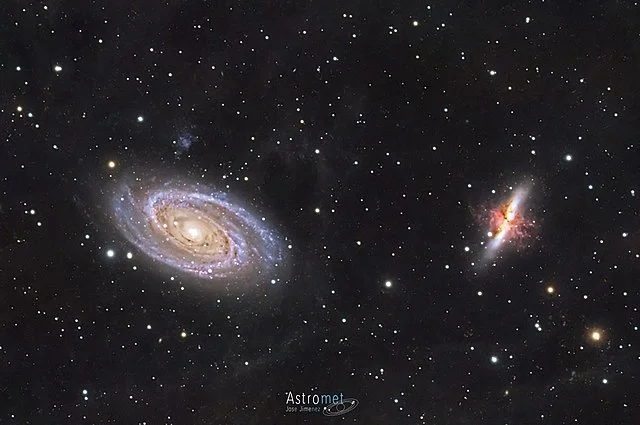
Bode’s Galaxy and the Cigar Galaxy (M81 and M82), image: José Jiménez (CC BY 2.0)
Cigar Galaxy – Messier 82 (M82, NGC 3034)
Messier 82 is an edge-on starburst galaxy about 11.5 million light years from the solar system. It has an apparent magnitude of 8.41.
Star formation that occurs in the galaxy’s core is ten times faster than star forming activity in the entire Milky Way. M82 is also about five times brighter than our galaxy. 197 massive star clusters were discovered by Hubble in the galaxy’s central region in 2005.
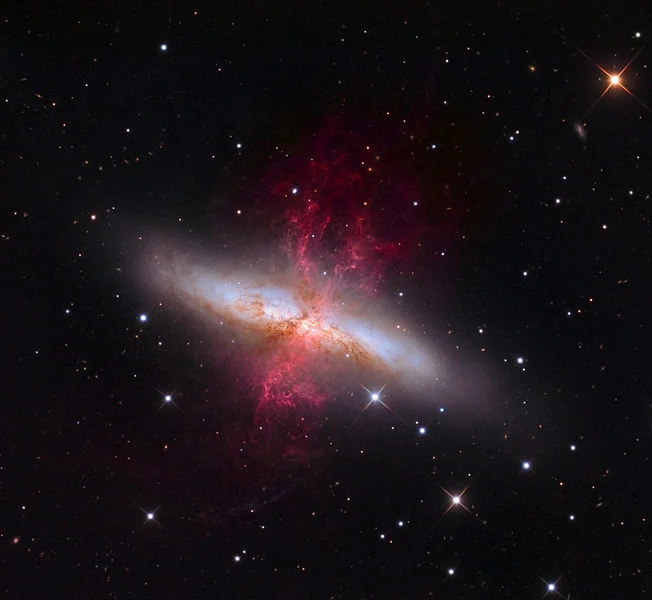
Cigar Galaxy (Messier 82), image: Adam Block/Mount Lemmon SkyCenter/University of Arizona (CC BY-SA 4.0)
M82 emits an infrared excess and is the brightest galaxy in the sky when observed in infrared light.
The Cigar Galaxy is believed to have had at least one tidal encounter with the neighbouring Messier 81 and, as a result, a large amount of gas ended up funneled into its core in the last 200 million years. Consequently, star forming activity in the galaxy has increased tenfold compared to most other galaxies.
M82 was discovered by Johann Elert Bode on December 31, 1774, along with M81. Bode originally described them both as nebulous patches.
Owl Nebula – Messier 97 (M97, NGC 3587)
The Owl Nebula is a planetary nebula about 2,600 light years away from the solar system. It has an apparent magnitude of 9.9. The nebula was first discovered by the French astronomer Pierre Méchain in 1781. It is believed to have formed about 8,000 years ago.
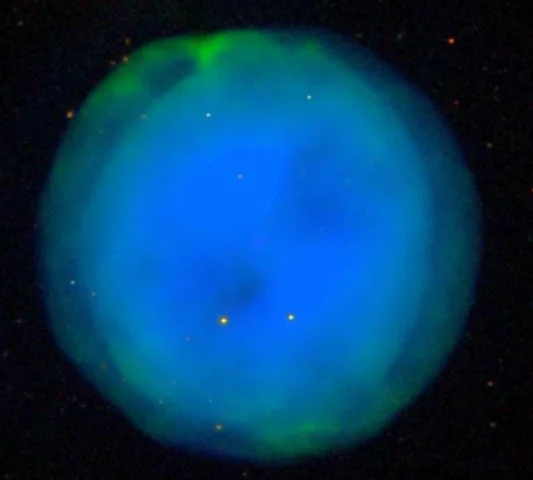
The Owl Nebula (Messier 97), image: Sloan Digital Sky Survey
The Owl Nebula has a 16th magnitude star at its centre. It got its name because of its appearance of owl-like eyes when observed through a large telescope.
Pinwheel Galaxy – Messier 101 (M101, NGC 5457)
The Pinwheel Galaxy is a grand design spiral galaxy seen face-on. It has an apparent magnitude of 7.86 and is 20.9 million light years distant from Earth. It was discovered by Pierre Méchain in 1781 and Charles Messier subsequently included it in his catalogue. It was among the last entries.
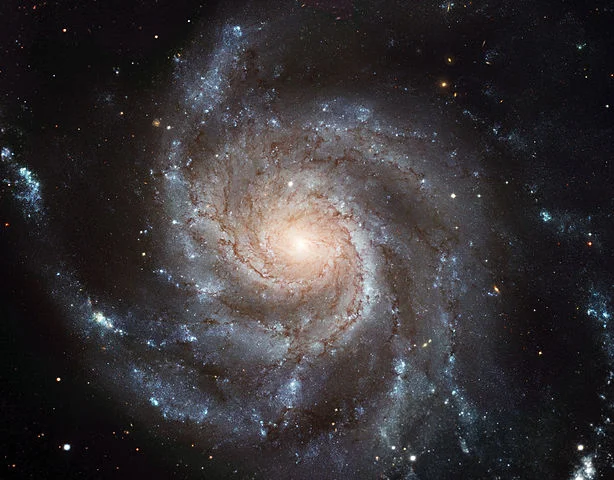
The Pinwheel Galaxy (Messier 101), image: European Space Agency & NASA. Acknowledgements: Project Investigators for the original Hubble data: K.D. Kuntz (GSFC), F. Bresolin (University of Hawaii), J. Trauger (JPL), J. Mould (NOAO), and Y.-H. Chu (University of Illinois, Urbana). Image processing: Davide De Martin (ESA/Hubble). CFHT image: Canada-France-Hawaii Telescope/J.-C. Cuillandre/Coelum. NOAO image: George Jacoby, Bruce Bohannan, Mark Hanna/NOAO/AURA/NSF.
A type Ia supernova, designated as SN 2011fe, was observed in the galaxy in August 2011.
Pierre Méchain described Messier 101 as a “nebula without star, very obscure and pretty large, 6′ to 7′ in diameter, between the left hand of Boötes and the tail of the great Bear. It is difficult to distinguish when one lits the [grating] wires.”
The Pinwheel Galaxy is about 170,000 light years in diameter, which makes it about 70 percent larger than the Milky Way galaxy. It contains a number of large, bright H II regions, full of bright, hot newly formed stars.
M101 has five notable companion galaxies: NGC 5474, NGC 5204, NGC 5477, NGC 5585 and Holmberg IV. The grand design pattern of the Pinwheel Galaxy is suspected to be a result of the interaction between the galaxy and its companions.
Messier 108 (M108, NGC 3556)
Messier 108 is a barred spiral galaxy, discovered by Pierre Méchain in 1781. From our perspective, the galaxy appears nearly edge-on.
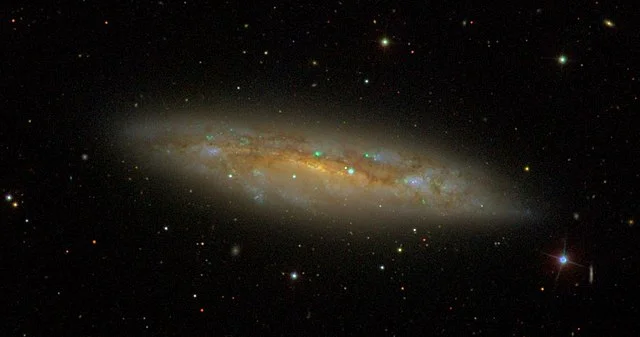
Messier 108, image: Sloan Digital Sky Survey
M108 is an isolated member of the Ursa Major Cluster, a galaxy cluster within the Virgo Supercluster. M108 contains about 290 globular clusters and 83 X-ray sources.
The galaxy has a visual magnitude of 10.7 and is approximately 45,000 light years distant. A type 2 supernova, 1969B, was observed in M108 in 1969.
Messier 109 (M109, NGC 3992)
Messier 109 is another barred spiral galaxy in Ursa Major. It is located southeast of the star Phecda (Gamma Ursae Majoris). The galaxy has an apparent magnitude of 10.6 and is 83.5 million light years distant.
Like the other notable galaxies in Ursa Major, M109 was discovered by Pierre Méchain in 1781. Charles Messier included it in his catalogue two years later.
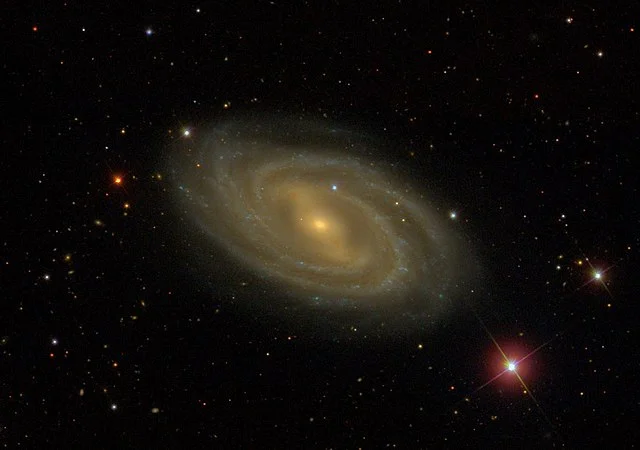
Messier 109, image: Sloan Digital Sky Survey
A type Ia supernova, SN 1956A, was seen in the galaxy in 1956. So far it has been the only supernova observed in M109.
M109 has at least three satellite galaxies, UGC 6923, UGC 6940 and UGC 6969. It is the brightest galaxy in the M109 Group, a large group consisting of more than 50 galaxies in Ursa Major.
NGC 5474
NGC 5474 is a peculiar dwarf galaxy in Ursa Major, located near the Pinwheel Galaxy (M101), with which it interacts. The galaxy is often classified as a dwarf spiral galaxy because it shows signs of a spiral structure. As a result of the tidal interactions with M101, the galaxy’s disk is offset from the nucleus, and so is the star formation.
NGC 5474 is the closest companion to M101. It has a visual magnitude of 11.3 and is approximately 22 million light years distant from the solar system.
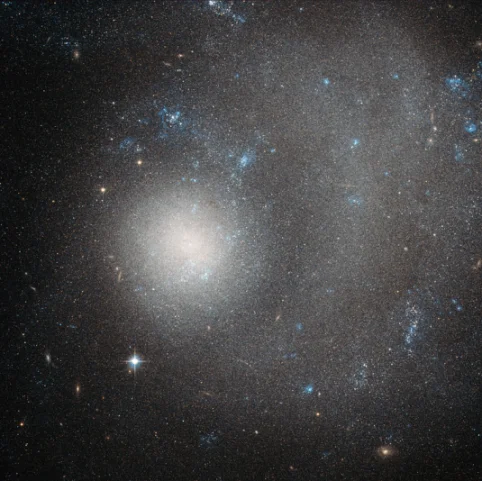
The subject of this Hubble image is NGC 5474, a dwarf galaxy located 21 million light-years away in the constellation of Ursa Major (The Great Bear). This beautiful image was taken with Hubble’s Advanced Camera for Surveys (ACS). The term “dwarf galaxy” may sound diminutive, but don’t let that fool you — NGC 5474 contains several billion stars! However, when compared to the Milky Way with its hundreds of billions of stars, NGC 5474 does indeed seem relatively small. NGC 5474 itself is part of the Messier 101 Group. The brightest galaxy within this group is the well-known spiral Pinwheel Galaxy (also known as Messier 101). This galaxy’s prominent, well-defined arms classify it as a “grand design galaxy,” along with other spirals Messier 81 and Messier 74. Also within this group are Messier 101’s galactic neighbors. It is possible that gravitational interactions with these companion galaxies have had some influence on providing Messier 101 with its striking shape. Similar interactions with Messier 101 may have caused the distortions visible in NGC 5474. Both the Messier 101 Group and our own Local Group reside within the Virgo Supercluster, making NGC 5474 something of a neighbor in galactic terms. Image: NASA/ESA
Helix Galaxy (NGC 2685)
The Helix Galaxy is a lenticular polar ring galaxy located 48.2 million light-years away. It has an apparent magnitude of 11.3 and appears near Muscida (Omicron UMa), in the region of the Great Bear’s head. It is one of the nearest polar ring galaxies to the Sun. The galaxy was discovered by the German astronomer Wilhelm Tempel on August 18, 1882.
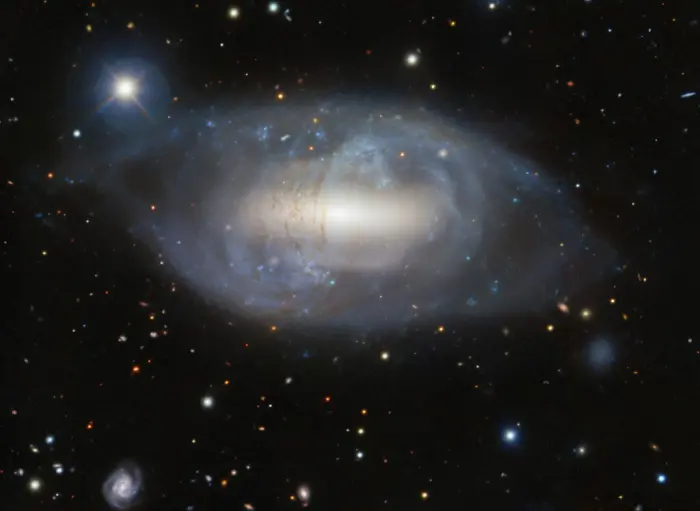
The very unusual galaxy NGC 2685, also known as the Helix Galaxy, is located about 40 million light-years away in the constellation Ursa Major. This image was captured by the Gemini North telescope, one half of the International Gemini Observatory, operated by NSF NOIRLab which is funded by the U.S. National Science Foundation. NGC 2685 is a peculiar lenticular galaxy known as a polar ring galaxy. A ring of gas, stars, and dust orbits NGC 2685 perpendicular to the flat plane of the host galaxy. This odd crossing of planes is believed to be evidence of galaxy interactions, mergers, or tidal accretion events. Current research suggests that the present structure of NGC 2685 was formed when it captured material from another galaxy, which was strung out into an encircling ring. This galaxy is one of our closest known polar ring galaxies and is therefore one of the easiest of its kind to study. Image credit: International Gemini Observatory/NOIRLab/NSF/AURA/L. Bassino Image processing: J. Miller (Gemini Observatory/NSF’s NOIRLab), M. Rodriguez (Gemini Observatory/NSF’s NOIRLab), & M. Zamani (NSF’s NOIRLab) (CC BY 4.0)